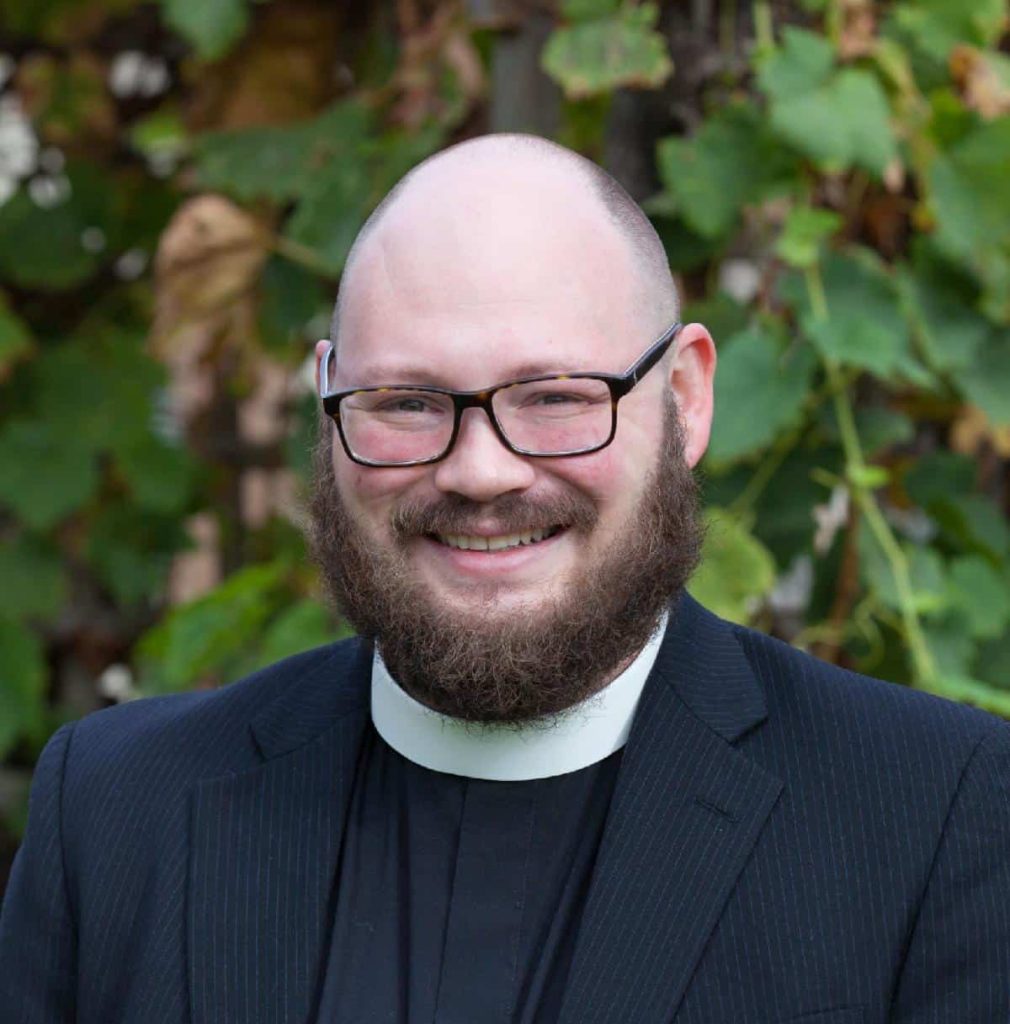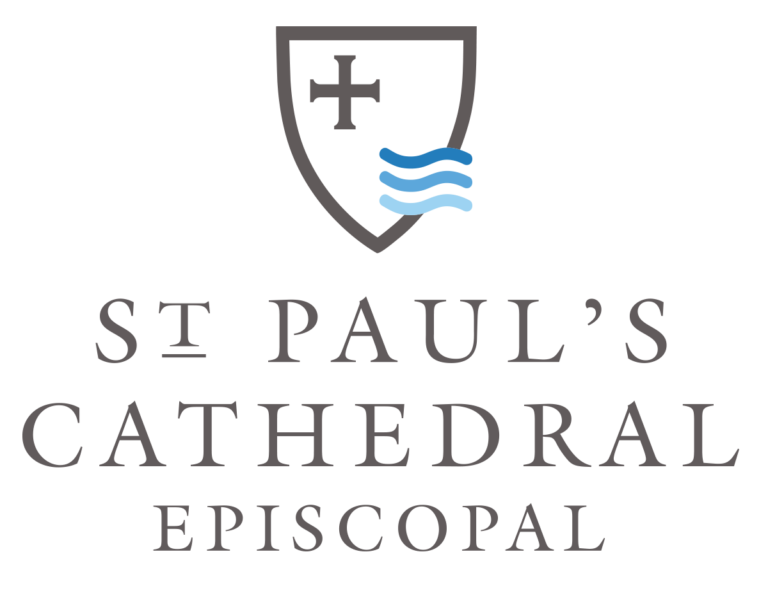
Rev. Richard Hogue Jr.
St. Paul’s Cathedral, San Diego
11/14/2021
Good morning! I am humbled to join you all today, and I want to thank Dean Penny and all owho have welcomed me into the life of St. Paul’s Cathedral. This week was a bit of a start-stop week for me, as I began to take on so much new information and filter out my final responsibilities at Holy Cross in Oceanside and St. Andrew’s in Encinitas. When I arrived in the diocese through St. Andrew’s in Encinitas in the fall of 2017, I had no conception of how our common ministry would grow together, and eventually lead me here with you all. This journey has only just begun, but I am thrilled to be on it with you all!
We encounter Jesus and the disciples towards the end of their journey in the Gospel of Mark this morning. We begin chapter 13 with Jesus exiting the Temple Mount and going to the Mount of Olives. Chapter 14 begins the Markan Passion narrative, where Jesus is captured and questioned, so everything we hear Jesus say from here until then is the final portion of his ministry pre-captivity and execution by the state. It is apocalyptic in tone, and warns of false leaders, famines, wars, earthquakes, but is ultimately a reassurance of the world yet to come. Since the arrival of the COVID-19 pandemic, perhaps we are done wanting to shake things up. But I want to assure you that it can be good to shake things up for ourselves.
When I was growing up, passages like the one we heard today were portrayed with Jesus as God and prophet, predicting and sanctioning the end of the Second Temple in Jerusalem decades prior, this is an interpretation that sees that prediction as a theological consequence for the Jewish people being led further from God by their scrupulous adherence to the Levitical and Deutoronomic laws, which were given by God’s self in that tradition. Much of my early growing up was in a somewhat bifurcated setting. My parents were both union members, carpenters for my father and teachers for my mother, and both Episcopalians. When we moved from northern Illinois to the north woods of Wisconsin in the early 1990s, my younger sister and I attended, and each graduated from, a very small, very conservative Christian school. It was supported by a local church that was biblically fundamentalist and later evolved into a Pentecostal-like church. On Sundays, though, we still would go to our local Episcopal church.
School days often held some amount of whiplash for us as kids. Our mom was a science teacher, and we’d listen to NPR and talk about the big bang and dinosaurs in the car on our way to school. Our schoolbooks, on the other hand, were from Bob Jones University, teaching six-day creationism, the impossibility of evolution or the earth being anything but six to ten thousand years old, and the evils of the Roe vs. Wade decision by the Supreme Court in these United States, among other things. After school, we’d get back in the car with mom and continue with our previous conversations.
It is only in retrospect that I see the white Christian nationalism in my life and that of our nation. At the time, it wasn’t a thing I could necessarily name, it was simply the state of existence. I believed that the folks who ran our school had good hearts, but their heads led them into strange places. Now, much further on, I am not as certain. Regardless, this dialectic shaped my upbringing, the way I understand society, and ultimately shaped my faith, its deconstruction, and continuing reconstruction. I think that deconstruction is somewhat what Jesus is talking about when he speaks of “Not one stone will be left here upon another; all will be thrown down.”
For me and my faith, the biggest stones fell after I graduated from Wabash College in Indiana in 2009. I became a missionary for the Episcopal Church through the Young Adult Service Corps and lived in Mthatha, South Africa, for a just about a year. There I worked in a medical clinic in a garbage dump slum, primarily providing care to HIV/AIDS and TB patients, among other responsibilities. With the theologies that I had operating within me to that point, I went off to change the world, because I had been equipped to better the world singlehandedly. Within the first hour I was there, the stones began to fall, as I took a fevered baby to a local hospital, but it died there. The white savior complexes that I didn’t even realize were present within me were crumbling. In their place God was planting something new, and I am still percolating on all that God is trying to teach me from that time.
I left South Africa to move to Jersey City, New Jersey in 2010. I became an intern of the Diocese of Newark through the Episcopal Service Corps and worked at the Hoboken Shelter, which sheltered unhoused people day and night with programming, showers, and hot meals. I stayed in the area for a couple more years, working as a missioner for a couple of local Episcopal churches before I was lifted up for ordination by All Saints in Hoboken. Along the way, more and more of my old ways of thinking began to crumble as God further shook my understanding of the world. When I arrived at seminary in Berkeley in the fall of 2013, I was eager to further shake things up, and began putting some things back together, but in ways I never expected.
For instance, I learned and was able to name theological phenomena I had grown up with in a new way. I learned about Christian supersessionism, the doctrine that Christianity is the replacement of the “old covenant” God had with the Jewish people, superseding it in every way. I also learned that bad theology kills, because there is a clear historical line between supersessionist theology, the oppression of Jews throughout millennia, through to the Holocaust itself. And once you start thinking about the practical implications of theological perspectives, you begin a cascade of new learning, stone after stone, as it were. Deconstruction, as I’ve found it, isn’t just about what ends, it’s about what we find and what we choose to do with the pieces we’re left with as we keep going.
So now, rather than reading a passage like this as a condemnation of Jewish institutions of his time, I now appreciate the historical point at which the Gospel of Mark is likely written, during the early portions of the First Jewish-Roman War, likely between 66-70AD. When we read it with that context in mind, it becomes less of a condemnation of Jewish people or the Temple, and more of a warning to escape the city of Jerusalem. The upheaval of civil war and the utter devastation the Roman military was so known for lurched toward the Holy City in the writer’s world. Instead of Jesus warning people about the end of the world, it is the end of the world as they knew it. Instead of being about rivals to Jesus, it becomes about not following the militarily ambitious into certain slaughter. With this in mind, we can begin putting together new meaning for ourselves, shaking off what cannot be left standing.
One might rightly ask what message we can take apart or rebuild as we sit in this beautiful temple of our own here at St. Paul’s in San Diego. British architectural historian Paul Johnson wrote that “the building of a cathedral is a story without an end.” [1] In many ways and for many years, St. Paul’s, as a congregation, has been constructing, deconstructing, and reconstructing. If we read merely the architectural history of this community we see that truth, and we experience it even now as we plan to move our offices and outreach activities in this coming year! [2] This is to say nothing of your efforts to deconstruct theologies of oppression against black and indigenous people of color and the LGBTQ+ community.
This community’s entire spirit is one of constant renovation, and it’s something Jesus encourages us to do! Shake things up, turn the world upside down! Then we find what is truly essential, and this and all else that is going on in the world will only be the beginning of the birth pangs of something new! I am so glad to join you in shaking things up, in ministry and in the world around us. I am so glad to begin this portion of the journey with you all. It’s far too early for me to speak of master plans, community organizing, or how we will meet and exceed our goals. Yet I am prayerfully convinced and convicted that we will accomplish great things together! May God bless us as we begin to take down and build back up together!
[1] A Gothic Architect in San Diego: Philip H. Frohman and the New St. Paul’s Church, 1920 – 1966; William A. Koelsch, https://sandiegohistory.org/journal/v51-1/pdf/2005-1_cathedral.pdf, accessed 11/12/2021
[2] Ibid.

